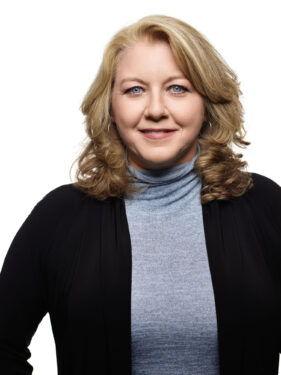FLATBUSH — Job security for frontline social workers, including specialists in mental health, is excellent as the field works to plug workforce shortages worsened by the COVID-19 pandemic.
For example, the need for mental health clinicians in outpatient behavioral health settings tripled since the pandemic, said Claudia Salazar of Catholic Charities Brooklyn & Queens.

Salazer is vice president of CCBQ’s Clinics, Recovery and Rehabilitative Services, which is scrambling to fill the gaps and meet future needs.
As of this writing, the careers page on CCBQ’s website lists “multiple positions” for social workers and mental health counselors. Hirees are eligible for a $3,000 sign-on bonus — a new practice for CCBQ to boost applications from qualified candidates. “We interview, but it’s more like they’re interviewing us now, because they have a choice of where they want to work,” Salazar said.
The trend is expected to last at least through 2031, reported the U.S. Bureau of Labor Statistics. This agency projects an estimated 74,700 openings for social workers nationwide each year over the next eight years.
“I can tell you that we’re at 50%,” Salazar said. “The majority of providers are probably working at 50% capacity or less.
“And it’s not just social workers. It’s licensed mental health counselors, it’s nurses, it’s psychiatrists, it’s psychiatric nurse practitioners.”
These are called “frontline” jobs because the nature of the work calls for professionals to work with clients in person.
Workloads and stress are heavy. But working for Catholic Charities, for example, upholds a Catholic mission to build the well-being, health, and dignity of all people.
“The Catholic Charities staff doesn’t turn their back on anybody,” Salazar said. “They really want to help those who are vulnerable and need help.”
Educational Opportunities
The demand is palpable at Fordham University, which prides itself on running the largest school of social work in New York state.
Fordham’s Graduate School of Social Service awards master’s degrees to about 1,000 students each year, said its dean, Debra McPhee.
“We are one of the largest, if not the largest in the country,” McPhee said. “But there’s more programs nationally now than ever before.”

She noted that 169 new social service programs opened at colleges and universities throughout the U.S. in the midst of the pandemic. The average program, she said, graduates 400 new social workers each year.
“So, it’s not that we don’t have enough social workers,” McPhee said.
The real issue, she said, is that there aren’t enough social workers filling the frontline jobs. That’s because they’re finding work in other sectors, McPhee said.
For example, they get better salaries in hospitals, schools, lobbying on Capitol Hill, and at high-tech start-up companies developing health care products.
These opportunities, McPhee said, are all “competing with those frontline jobs.”
McPhee said that the average social worker with a master’s degree in New York City earns an annual salary of about $54,000. Meanwhile, the city’s cost-of-living expenses are among the highest in the world.
Also, the average debt load for graduates of a private college like Fordham is around $70,000, the dean said.
McPhee serves on the board of trustees for Catholic Charities of New York, so she understands fiscal challenges faced by nonprofit agencies.
“It is a major issue to find qualified people and then recruit and retain them,” McPhee said. “It’s very difficult for places like Catholic Charities which have been the backbone of social services in New York City for generations.
“They do it on a shoestring quite often.”
Already Shorthanded
Beyond training and experience, the modern-day social worker must become an expert in “self care” to stave off burnout that was amplified during COVID and growing migrant influx into the city.
Stressors within the mental health workforce were well documented pre-pandemic.
“There was already a shortage in terms of mental health providers, which created a lot of issues,” Salazar said.
In 2013, the peer-reviewed journal “Health Affairs” reported that social workers were seeing “high burnout and turnover rates.” Causes were underfunding of public behavioral health programs, low wages, and high case load demands, according to the report.
The situation worsened when the pandemic hit New York City and the U.S. in early 2020.
Demand Tripled
Outpatient clinics, like those operated by CCBQ, took on the added task of helping people with severe mental health conditions.
“The hospitals were inundated with COVID patients,” Salazar said. “So there were no psychiatric beds.”
The CCBQ team became overwhelmed, “because the demand tripled,” Salazar said. “Our clinics were in the epicenter of COVID. We had clients whose whole families were wiped out.”
Meanwhile, the New York state government required agencies like CCBQ to stay open to help the clients with severe cases.
Staff members worked on-site, but they rotated in and out on altered schedules to limit exposures to the disease, Salazar said.
“That in itself was traumatic for them,” she said, “because they didn’t feel safe. A lot of them were having to deal with their own COVID issues, whether they had it themselves, or they had family members they lost.”
The pandemic’s legacy persists, Salazar said.
Much of it is “vicarious” trauma, whereby the clinician or social worker becomes severely disturbed by the client’s situation.
For example, she said, the staff began seeing more “adolescents and children with suicidal and homicidal ideations. “Our clinicians were not prepared for that,” she added. “They are now because we’ve done a lot of training around these issues, but it still takes a toll.”
Mental health staffing was static during the pandemic because lockdowns restricted movement for everyone, Salazar said. But, she added, once COVID and its social distancing restrictions ebbed, a “big exodus” ensued in the New York City mental health field.
“A lot of the workforce decided to go back to their home states and be with family,” Salazar explained. “But it was also a combination of burnout and wanting to go into a different field. Their priorities changed.”
McPhee said it is ironic that social workers were considered “essential workers” during the pandemic, yet were paid “so little compared to other workers.
“These dedicated people want to change the world and make it better for vulnerable people,” McPhee said. “Unfortunately, we’re not a country that necessarily values them in ways that will keep their well-beings protected, just to continue this work.”
McPhee said Fordham will keep helping its students with assistance programs such as scholarships.
But, she added, as the nation puzzles through fair compensation for social workers, lawmakers in Albany can also ease their burdens. She suggested a more streamlined approach to licensing at the Office of Professions, a division of the New York State Education Department.
CCBQ is taking steps to enhance recruitment beyond sign-on bonuses, Salazar said.
“Professional development” days on Fridays, for example, give staffers a break from seeing clients, unless there’s a crisis. This allows them to work on other tasks, like completing paperwork.
It also lets them leave for the weekend without a huge workload.
“So that’s given them a little bit of a respite,” Salazar said. “They need to take care of themselves, but they will put the needs of others first, to make sure they’re safe, to make sure they’re being taken care of. People in this field are just selfless individuals.”

